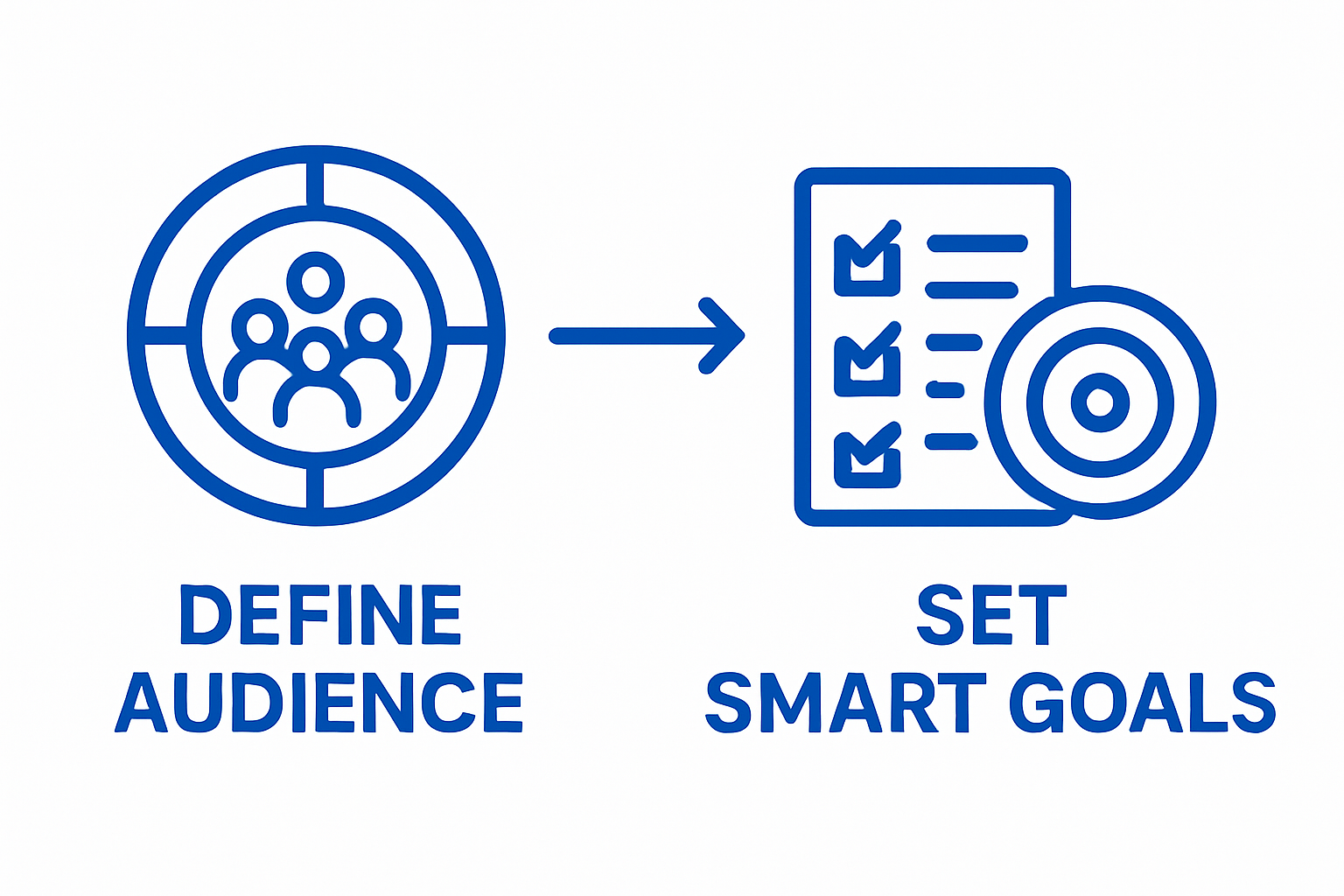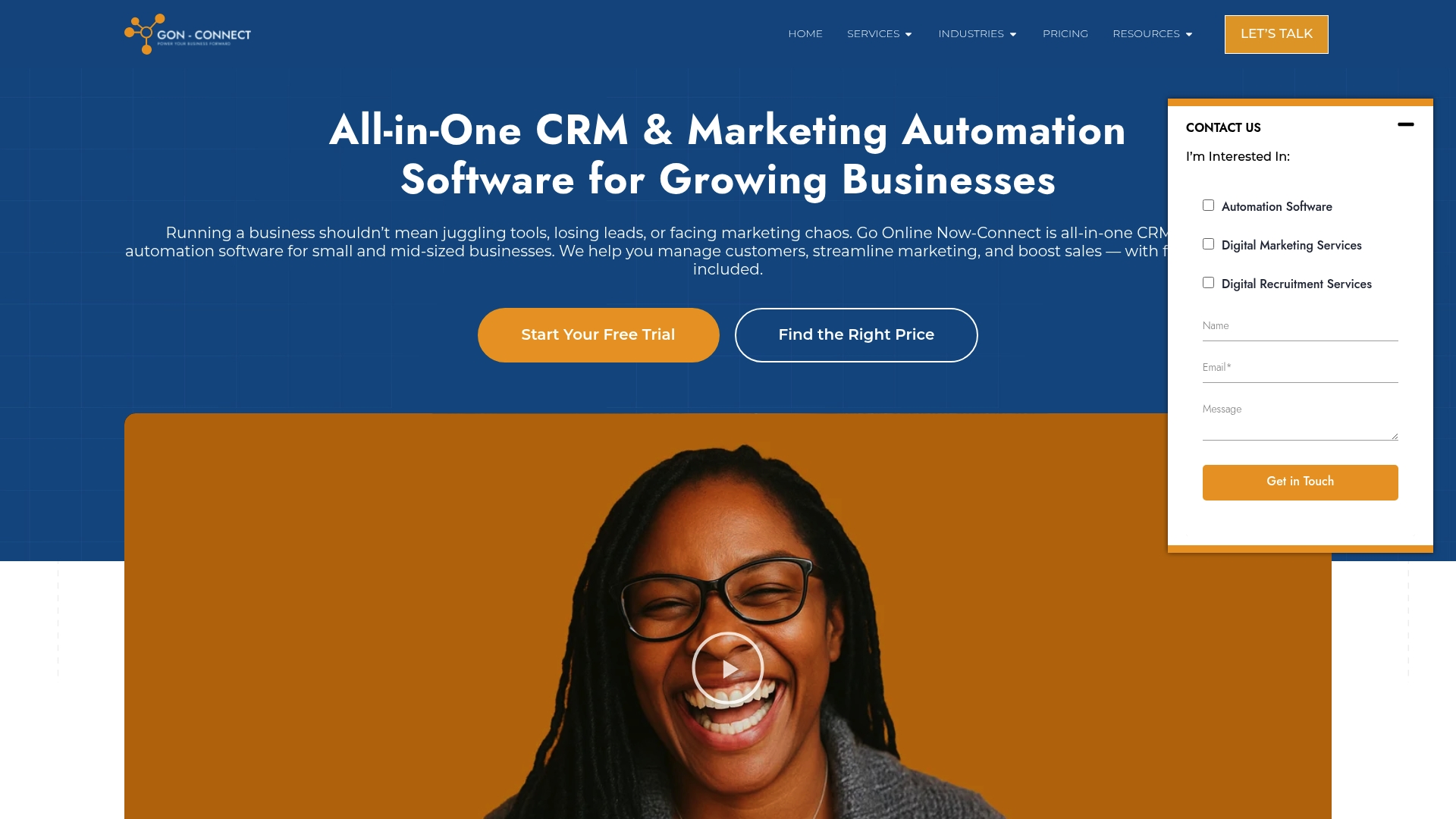Building a digital marketing strategy can feel overwhelming. There are so many moving parts and it is easy to get lost before you ever see results. But here is something most people miss. Businesses that define their audience from the start and use demographic research as a strategic compass see far stronger returns and clearer direction. Most folks think smart tactics matter most, but the secret sauce is understanding exactly who you’re speaking to and why your goals truly matter. Ready to see what actually sets great strategies apart? Keep reading.
Step 1: Define Your Target Audience and Goals
Building a successful digital marketing strategy begins with crystal clear audience understanding and goal setting. Imagine trying to navigate a complex journey without knowing your destination or the terrain – that’s precisely what happens when businesses skip this critical first step in their digital marketing strategy tutorial.
Starting with audience definition means transforming vague assumptions into precise, actionable insights. Demographic research becomes your strategic compass. Begin by gathering comprehensive information about your potential customers. What are their age ranges? What income levels do they represent? What professional backgrounds or industries do they come from? These details help you craft messaging that resonates deeply.
To conduct meaningful audience research, leverage tools like Google Analytics and social media insights platforms. These resources provide granular data about your current website visitors and social media followers. Analyze their behaviors, interests, and engagement patterns. Pay special attention to psychographic details – their aspirations, challenges, and motivational triggers that drive purchasing decisions.
Parallel to audience identification, establish SMART goals for your digital marketing efforts. SMART stands for Specific, Measurable, Achievable, Relevant, and Time-bound. Instead of saying “I want more customers,” articulate a precise objective like “Increase online sales by 25% within the next six months through targeted social media advertising and email marketing campaigns.”
Your goals should align with broader business objectives and include clear key performance indicators (KPIs). These might include metrics such as website traffic, conversion rates, lead generation numbers, or social media engagement levels. By connecting your digital marketing strategy to tangible business outcomes, you create a powerful framework for measuring success and making data-driven adjustments.
Successful audience definition and goal setting require ongoing refinement. Treat this process as dynamic, not static. Regularly review your audience personas and marketing objectives, adjusting them based on emerging market trends, customer feedback, and performance data. This adaptive approach ensures your digital marketing strategy remains responsive and effective.
Below is an overview table summarizing each key step in building an effective digital marketing strategy, including focus areas and desired outcomes.
| Step | Main Focus | Key Actions | Outcome |
|---|---|---|---|
| 1 | Define Audience & Goals | Audience research, set SMART goals | Clear target & measurable objectives |
| 2 | Conduct Competitor Analysis | Analyze competitors, SWOT assessment | Identify gaps and opportunities |
| 3 | Develop Unique Value Proposition | Clarify what makes you different, test messaging | Distinctive market position |
| 4 | Create Marketing Plan | Select channels, set budget, create content calendar | Cohesive and actionable strategy |
| 5 | Implement & Monitor | Launch campaigns, track performance | Data-driven adjustment and execution |
| 6 | Evaluate & Optimize | Review analytics, refine strategy | Continuous improvement and growth |

Step 2: Conduct a Competitor Analysis
Competitor analysis transforms your digital marketing strategy from guesswork into a precision-driven approach. This crucial step helps you understand the competitive landscape, revealing opportunities and potential strategic advantages that can set your brand apart in the digital marketplace.
Begin by identifying your direct and indirect competitors. Direct competitors offer similar products or services in your specific market, while indirect competitors might solve the same customer problems through different approaches. Use search engines, industry directories, and professional networking platforms to create a comprehensive list of businesses operating in your space.
Next, perform a thorough digital footprint investigation. Examine your competitors’ websites, social media channels, content marketing strategies, and online advertising approaches. Pay close attention to their messaging, visual branding, and engagement tactics. Tools like SEMrush can provide invaluable insights into competitors’ keyword strategies, website traffic, and digital marketing performance.
Analyze their content strategy with a critical eye. What type of content are they producing? How frequently do they publish? Which platforms generate the most engagement for them? Understanding these elements helps you identify gaps in their approach and potential opportunities for differentiation. Look beyond surface-level observations and dig into the nuanced aspects of their digital presence.
Perform a systematic SWOT (Strengths, Weaknesses, Opportunities, Threats) analysis for each significant competitor. Document their digital marketing strengths and weaknesses, noting areas where your brand can potentially outperform them. This might involve creating more engaging content, targeting underserved audience segments, or developing more innovative digital marketing techniques.
Remember that competitor analysis is not about copying but about understanding. The goal is to learn from their strategies while developing a unique approach that authentically represents your brand. Continuous monitoring is key – digital marketing landscapes evolve rapidly, and what works today might become obsolete tomorrow. Set up regular review cycles to keep your competitive insights current and actionable.
To verify the effectiveness of your competitor analysis, ensure you have a comprehensive report that includes detailed insights, potential strategic opportunities, and clear recommendations for differentiating your digital marketing approach. This document becomes a living strategy guide that will inform your subsequent marketing decisions.
Step 3: Develop Your Unique Value Proposition
A unique value proposition (UVP) is the strategic heartbeat of your digital marketing strategy, distinguishing your brand in a crowded marketplace. This critical step transforms your business from a generic service provider into a distinctive solution that speaks directly to your target audience’s specific needs and desires.
Crafting an exceptional UVP requires deep introspection about what truly sets your business apart. Start by identifying the core problems your product or service solves. This isn’t about listing features, but understanding the genuine transformation you deliver to customers. Consider the emotional and practical outcomes your customers experience when they choose your brand.
Begin the development process by asking penetrating questions about your business. What unique combination of skills, approaches, or technologies do you offer? How do you solve customer problems differently from competitors? What unexpected benefits do your clients receive? The most compelling value propositions bridge the gap between functional solutions and emotional resonance.
Your UVP should be concise, clear, and immediately communicative. Aim to create a statement that can be understood in five seconds or less. Prioritize clarity over cleverness. A powerful UVP typically follows a structure that answers three fundamental questions: What do you offer? Who is it for? How are you different from alternatives?
Develop multiple draft versions of your UVP and test them with your target audience. Use tools like SurveyMonkey to gather feedback and refine your messaging. Pay attention not just to what people say, but how they react emotionally to your proposed value proposition. The most effective UVPs create an immediate sense of recognition and connection.
Remember that your unique value proposition is not a static document but a living strategic asset. It should evolve as your business grows, market conditions change, and customer needs shift. Schedule regular reviews of your UVP, typically every six to twelve months, to ensure it remains relevant and compelling.
To verify the effectiveness of your UVP, assess whether it passes the “so what?” test. If someone reads your value proposition and their immediate response could be “so what?”, you need to dig deeper. A truly powerful UVP creates an instant spark of interest, making potential customers lean in and want to learn more about your unique solution.
Step 4: Create a Comprehensive Digital Marketing Plan
A comprehensive digital marketing plan transforms scattered tactics into a cohesive, strategic roadmap that drives meaningful business growth. This critical step synthesizes all previous research and insights into a structured approach that aligns your marketing efforts with your core business objectives.
Channel selection becomes your strategic foundation. Not all digital platforms will be equally effective for your specific business. Carefully evaluate where your target audience spends their online time. For some businesses, LinkedIn might be a powerhouse, while others find more traction on Instagram or YouTube. Consider the unique characteristics of each platform and how they align with your brand’s communication style and audience preferences.
Budget allocation requires precision and flexibility. Divide your marketing resources strategically across different channels, ensuring you have room for experimentation and optimization. Tools like Google Ads provide robust tracking and performance measurement capabilities that can help you make data-driven decisions about where to invest your marketing dollars.
Content strategy sits at the heart of your digital marketing plan. Develop a robust content calendar that maps out your messaging across different platforms. This isn’t just about frequency, but about creating a narrative that resonates with your target audience. Consider the buyer’s journey – from awareness to consideration to decision – and craft content that speaks to each stage of that progression.
Implement a measurement framework that goes beyond vanity metrics. Track meaningful indicators that directly connect to your business goals. This might include conversion rates, customer acquisition costs, engagement levels, and ultimately, revenue generated from digital marketing efforts. Use analytics tools to create dashboards that provide real-time insights into your marketing performance.
Remember that a digital marketing plan is a living document. Build in regular review cycles – monthly or quarterly – to assess performance, identify areas for improvement, and adapt to changing market conditions. The most successful digital marketing strategies remain flexible and responsive to emerging trends and audience feedback.
To verify the completeness of your digital marketing plan, ensure you have clear documentation that answers these key questions: What are our specific marketing goals? Which channels will we use? What type of content will we create? How will we measure success? How much will we invest in each channel? A well-constructed plan leaves no room for ambiguity and provides a clear strategic direction for your digital marketing efforts.

Step 5: Implement and Monitor Your Strategy
Implementation marks the critical transition from strategic planning to real-world execution. This step transforms your meticulously crafted digital marketing strategy from a theoretical document into a dynamic, living business approach that generates tangible results.
Launch your digital marketing initiatives systematically. Begin by establishing a clear implementation timeline with specific milestones and responsible team members. Each channel and campaign requires carefully orchestrated rollout, ensuring messaging consistency and technical readiness. Tools like Trello can help track progress and maintain accountability across different marketing initiatives.
Monitoring becomes your strategic compass during implementation. Set up comprehensive tracking mechanisms that capture granular performance data across all digital channels. Real-time analytics provide insights that allow for rapid strategic adjustments. Use platforms that offer integrated dashboards, enabling you to observe performance metrics, audience engagement, and conversion rates from a centralized perspective.
Develop a robust feedback loop that allows for continuous optimization. This means creating systems to quickly interpret performance data and make informed adjustments. Pay close attention to both quantitative metrics (click-through rates, conversion percentages) and qualitative signals (audience comments, sentiment analysis). The most successful digital marketing strategies remain fluid, responding dynamically to emerging data and market shifts.
Be prepared for unexpected challenges during implementation. Some campaigns might underperform, while others exceed expectations. Maintain flexibility in your approach, willing to pivot strategies based on real-world performance. This might involve reallocating budget, adjusting messaging, or exploring alternative marketing channels that show more promising initial results.
Establish a regular review cadence – weekly for tactical adjustments and monthly for strategic reassessment. During these reviews, evaluate key performance indicators against your original objectives. Look beyond surface-level metrics to understand the deeper narrative about your marketing efforts. Are you genuinely connecting with your target audience? Are your messaging and channels effectively communicating your unique value proposition?
To verify successful implementation and monitoring, ensure you have a comprehensive performance dashboard that tracks progress across all defined metrics. This dashboard should clearly show whether you are meeting, exceeding, or falling short of your original marketing objectives. The most effective digital marketing strategies are those that remain adaptable, data-driven, and committed to continuous improvement.
This table organizes essential tools and resources mentioned in the article, with descriptions of their main purpose for each step in the digital marketing strategy process.
| Tool/Resource | Main Use | Related Step(s) |
|---|---|---|
| Google Analytics | Audience insights, monitoring, performance tracking | Define Audience, Evaluate |
| SEMrush | Competitor analysis, keyword research | Competitor Analysis |
| Social Media Insights | Understand audience demographics and engagement | Define Audience |
| SurveyMonkey | Test and refine UVP and messaging | Unique Value Proposition |
| Google Ads | Paid campaign management and budget tracking | Marketing Plan, Implementation |
| Trello | Track implementation tasks, team coordination | Implementation |
| Analytics Dashboards | Measure KPIs and optimize performance | Monitor, Evaluate & Optimize |
Step 6: Evaluate and Optimize for Better Results
Evaluation and optimization represent the critical final stage of your digital marketing strategy, transforming raw performance data into actionable insights that drive continuous improvement. This step is about understanding not just what happened, but why it happened and how you can leverage those insights for future success.
Data becomes your strategic roadmap. Utilize advanced analytics tools to dig deep into performance metrics across all digital marketing channels. Google Analytics provides comprehensive insights that go beyond surface-level numbers. Look for patterns in user behavior, conversion rates, engagement levels, and customer journey trajectories. Each data point tells a story about your marketing effectiveness and potential areas for enhancement.
Develop a systematic approach to performance analysis. Create a comprehensive dashboard that consolidates metrics from all digital platforms, allowing you to see a holistic view of your marketing performance. Pay special attention to the correlation between different marketing efforts. Which channels are driving the most valuable conversions? Where are potential customers dropping off in the sales funnel? Understanding these interconnected dynamics helps you make precise, targeted optimizations.
Optimization is an iterative process that requires both strategic thinking and creative problem-solving. When you identify underperforming campaigns or channels, resist the urge to make sweeping changes. Instead, implement incremental adjustments and carefully track their impact. This might involve refining audience targeting, adjusting messaging, experimenting with different content formats, or reallocating budget to more effective channels.
Establish a culture of continuous learning within your marketing team. Regular performance review sessions should be more than just number-crunching exercises. Encourage open discussions about what worked, what didn’t, and why. Create a collaborative environment where team members feel empowered to propose innovative optimization strategies based on the data.
Remember that optimization extends beyond technical metrics. Consider qualitative feedback from customers, changes in market dynamics, and emerging digital marketing trends. The most successful digital marketing strategies remain adaptive, constantly evolving to meet changing customer needs and technological landscapes.
To verify the effectiveness of your evaluation and optimization efforts, ensure you can demonstrate clear, measurable improvements in key performance indicators. Can you show reduced customer acquisition costs? Increased conversion rates? Improved engagement metrics? A successful optimization process turns data into demonstrable business value, continuously refining your digital marketing approach.
Ready to Build Your Brand Online Without the Stress?
You have seen how defining your audience, setting SMART goals, and executing a solid digital marketing plan can set your business apart. But trying to bring these strategies to life with scattered tools or overpriced software can leave you overwhelmed. Many small businesses spend weeks wrestling with complicated setups, missing client messages, and wasting resources chasing after results they never achieve. What if you could have every essential marketing automation tool, a complete CRM, and live human support all in one place?

Stop struggling with disconnected systems or delayed results. Experience true business growth with Go Online Now-Connect — the affordable all-in-one platform designed for ambitious SMBs and SMEs ready to convert strategy into success. Our team sets you up, manages your automations, and helps you measure progress every step of the way. Start your journey now and see how our marketing automation software for small business delivers proven results, transparent pricing, and real support. Visit https://goonlinenow.co to get your brand growing online today.
Frequently Asked Questions
What is a digital marketing strategy?
A digital marketing strategy is a comprehensive plan that outlines how a business will engage customers online to achieve its marketing goals. It involves understanding your target audience, setting specific goals, analyzing competitors, and determining the best channels and tactics to use.
How do I define my target audience for digital marketing?
To define your target audience, conduct demographic research to gather insights on their age, income level, profession, and interests. Utilize tools like Google Analytics and social media insights to analyze your existing customer base and develop detailed audience personas that reflect their behaviors and motivations.
What is a unique value proposition (UVP) and why is it important?
A unique value proposition (UVP) clearly articulates what makes your product or service different from competitors. It identifies the specific benefits and solutions you offer to your customers, helping to establish a competitive edge and communicate effectively with your target audience.
How can I measure the success of my digital marketing strategy?
You can measure the success of your digital marketing strategy by tracking key performance indicators (KPIs) such as website traffic, conversion rates, engagement levels, and revenue generated from marketing efforts. Using analytics tools can help you create dashboards that provide insights into these metrics and guide your ongoing strategy optimization.

